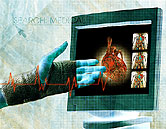
TUESDAY, Nov. 16 (HealthDay News) — Stem cells taken from the belly fat of 10 heart attack patients managed to improve several measures of heart function, Dutch researchers report.
This is the first time this type of therapy has been used in humans, said the scientists, who presented their findings Tuesday at the American Heart Association’s annual meeting in Chicago.
But the improvements, though relatively dramatic in this small group of patients, were not statistically significant, probably due to the limited number of participants in the study. And another expert urged caution when interpreting the results.
“The key issue is whether a treatment makes us live longer or feel better,” said Dr. Jeffrey S. Borer, chair of the department of medicine and of cardiovascular medicine at the State University of New York (SUNY) Downstate Medical Center in New York City.
This study only looked at “surrogates,” meaning measures of heart function that might predict better future health in the patient, he said.
“This cannot be interpreted as if they directly represent positive clinical outcomes,” Borer said. “These certainly are promising stem cell data, but there’s a great deal more to do before it is possible to know whether this is a viable therapy.”
Another caveat: All the patients in this trial were white Europeans. The study authors believe the results could be extrapolated to much of the U.S. population, but not necessarily to people who aren’t white.
Fat tissue yields many more stem cells than bone marrow (which has been studied before) and is much easier to access.
In bone marrow, 40 cubic centimeters (cc) typically yield about 25,000 stem cells, which is “not nearly enough to treat people with,” said study author Dr. Eric Duckers, head of the Molecular Cardiology Laboratory at Thoraxcenter, Erasmus University Medical Center in Rotterdam. To get enough cells to work with, those stem cells would have to be cultured, a process that can take six to eight weeks, he said.
By contrast, 100 cc’s of fat tissue yield millions of stem cells, plenty to work with. A hundred cc’s is about the size of a coffee cup — a European coffee cup, not the mega-size of American coffee containers, Duckers emphasized.
“With that many cells, you can isolate them and give them to the patient right away as they come into the hospital,” he explained.
All patients in this double-blind, placebo-controlled study (11 men and three women) arrived at the hospital having suffered a severe heart attack. All then underwent cardiac catheterization to assess blood flow, followed by percutaneous coronary intervention (PCI), more commonly known as angioplasty, to restore blood flow.
Within 24 hours of the heart attack, doctors performed liposuction to remove fat tissue, isolated 20 million stem cells and gave them back to the patients through a catheter. The infusion took no more than 10 minutes. Ten patients received stem cells and four received a placebo infusion.
“It was done very, very quickly, all in the same day,” Duckers said.
Six months after the procedure, stem cell patients had better blood flow (more than triple the rate compared to patients getting a placebo), a 5.7 percent increase in heart pumping ability, and a 50 percent reduction in scarring of heart muscle (from 31.6 percent right after the heart attack to 15.4 percent). Placebo patients saw no decrease in scarring.
“In theory,” Borer said, “the use of stem cells to improve myocardial perfusion [blood flow] and cardiac performance is very promising… but to the present time, although many approaches to stem cell use have been tested, there really has not yet been evidence of a clinically useful important result. That doesn’t mean that stem cell research isn’t an important lead to follow.”
The Dutch research team is now embarking on a trial that will ultimately enroll 375 heart attack patients at 35 medical centers in the European Union to further test stem cell infusions.
The study was funded by Cytori Therapeutics Inc.
More information
The U.S. National Institutes of Health has more on stem cells.

